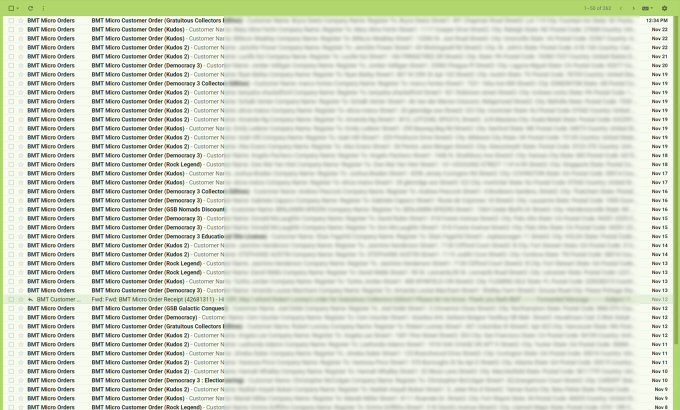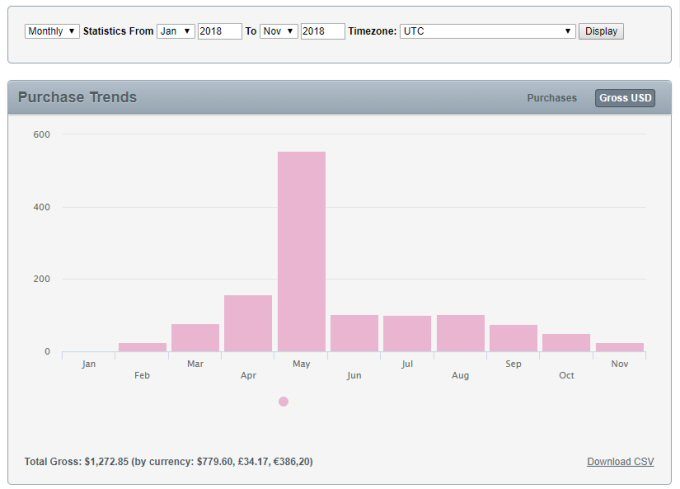Eight years ago I wrote this article on how to sell your game direct without an app store. It was fairly popular at the time. Its now late 2018 and a lot has changed. Steam is still popular, but origin is also doing well, there are rumblings about Epic starting a store, we also have amazon, kartridge, GoG, the humble store and itch.io as competitors. We also have a lot more indie devs (a LOT more), and its long overdue revisiting the topic. BTW, maybe I should hyperlink all those store names….but nah, they don’t link to *my* site so…
Anyway, are direct sales a good thing still? is it viable? how do you go about doing it.
Is this viable?
Firstly do not believe anyone who tells you that NOBODY buys games direct any more. They totally do. I get enough sales (still) through BMTMicro (who I hardly use any more) to warrant me filtering them into an email folder:

As a percentage of my sales, its not huge, but its certainly not to be sniffed at. In the last 365 days my earnings from direct sales through BMTMicro are $18,457. My direct sales through other services charging a very similar cut are about $16,000. Put those two together and you get about $34,000 sold at a 5% cut instead of a 30% cut. The saving per year? $8,900. Could you do with an extra income of almost $9k a year as an indie dev? its definitely not to be sniffed at. The situation is vastly better when you look at releasing a game initially from your own site, before its on any store. Doing this generated an EXTRA $108,000 on the two most recent game launches where I did this. Thats effectively *free* money.
So myth#1, that you cannot sell enough games direct to make it worth the bother of doing so, is definitely busted. It absolutely can. And if you want a more dramatic example, maybe you should recall that minecraft did exactly this. As I recall, sales were good.
So given that this *can* be done, the two remaining question I guess are *should* you do it, and how do you do it.
The only two reasons I can think of *not* to do direct sales are time/effort and concerns about the stores. Lets deal with them in order.
What is involved?
People VASTLY exaggerate the amount of hassle required in direct sales. Do you not have your own website already? selling and existing online ONLY through steam? Ok cool, you are not really an indie, and I suggest you actually start at basic principles and get your own independent site… Anyway, assuming you do, how hard is it to add a ‘buy now’ page? Heres the page for production line.
Note that the only traditionally ‘difficult’ bit is adding a buy button, something that the humble widget already provides for you, its literally ‘click here to get an embeddable widget for your website’. I can even embed it here:
So that side of it is easy. The next bit is uploading and updating builds. This sounds like way more of a chore than it is, unless you have absolutely DIRE internet. Itch.io support partial builds apparently, but annoyingly humble and bmtmicro do not (which frankly is ridiculous…). Even so… how many updates do you do? I used to have 1MB up internet and still did it. Uploading a new installer is really not hard work. Also coding an autoupdate check for your games and telling the player to update is also pretty easy. I check a text file on my server on startup, which has the latest version, and downloads an updated changelist to display to the player to encourage them to re-download and re-install. Its a few lines of php.
So uploading a build and setting up the buy page are trivial. What else is hassle? You obviously need to tell itch/bmt/humble your bank details, but you have already done this with GoG/Steam etc anyway. Some services, like BMT, allow you to choose how often you get paid, so as to minimise the amount of bank charges you have to deal with. Any decent payment provider also provides charting and sales reports. here are some from humble and BMTMicro.


The big difference between direct and store sales is that with direct sales, if you wish, you can access the email addresses of the customers. This may involve some GDPR related shenanigans, but depending on jurisdiction, this at least gives you a stronger direct connection to the buyer. You can add an email signup to your order form, and build up your own mailing list to notify customers direct of future updates and new games etc. Something else thats different is that in some cases, direct-payment companies let you choose *when* to be paid. If you don’t live in a $ country and build up a $ balance, having control over when that happens can be convenient. Personally, I keep a $ bank account in the UK so its not an issue (I can pick the best conversion moment at another time).
With a service like BMT Micro, you can ask to be sent any requests for refunds so you can approve/deny them or contact the player direct. The amount of refund requests that actually turn out to be a simple request for tech support over something minor (like trying to run the windows installer on a mac, or having an antivirus false positive etc) is quite surprising. Why put a third party between you and your players?
Basically direct-sales are no hassle. You NEVER see the customers credit card details or passwords or anything. You do NOT handle VAT or sales tax, thats all handled for you. Its basically exactly the same as selling on a store, except you keep 90-95% instead of 70% (minus refunds & sales tax). Oh BTW, you can choose to have sales tax added at the point of sale instead of just absorbing it.
Reasons to be scared
The other argument is that selling direct will be bad because either the stores will hate you, or because you miss out on decent reviews or visibility on steam/GoG etc by siphoning off the early customers. I think both are unfounded but I should at least mention them. I truly believe that the big stores are not going to be annoyed at/vindictive towards developers who also sell direct. This is the very definition of fair competition. I’ve been selling direct for TWENTY years and have never noticed this affect my relationship with any store. Steam especially seem very understanding that a lost sale is just a market signal. Free competition is a good thing, and no store has ever, to my knowledge, behaved badly towards a developer selling direct. Besides, if you even for 1 second think a store you deal with might be this evil, you should audit the hell out of them right now, because you realize you are just trusting them to report sales accurately right?
So will those ‘lost’ sales reduce your impact on the stores. I suspect yes. Big Pharma and Production Line both look a bit less successful on steam because both had a ton of direct sales ‘off-steam’. I don’t care. The impact might be non-negligible, but the sweet extra 25% of those early sales more than covers it. It seems an oft-repeated piece of wisdom (with no hard data) that if you push all your customers through steam on day one that you will get huge ‘launch visibility’. I have not seen this to make an earth shattering difference.
Also, think about what you are doing. You are like someone who recorded an album, a fan knocks on your door with $20, and you tell him to walk to the record store and hand it to them so you can get your $14 (at most). Thats madness.
Conclusions
Selling direct has never been easier, or with more options. There are very few reasons not to do it. Setup is easy. I have over a dozen games on maybe five different stores and 2 different direct payers, and royalty agreements with 3 devs, and I manage it all on my own, as well as coding and designing a game, producing another, writing this blog and probably 100 other things and I’m 49 years old. I cannot imagine how a small ‘team’ of highly energetic indie devs cannot find the time to set up an account on itch.io. After all, you do want to be INDEPENDENT game developers right?